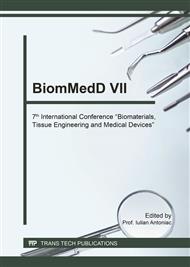[1]
Bratila E., Bratila P., Laparoscopically Assisted Vaginal Colpohisterosacropexy, The Ginecologia. ro, 6(2) (2010) 118-122.
Google Scholar
[2]
Brătilă, E., Comandasu, D., Milea, C., Berceanu, C., Vasile, E., Antoniac, I., Mehedintu, C., Effect of the surface modification of the synthetic meshes used in the surgical treatment of pelvic organ prolapse on the tissue adhesion and clinical functionality, Journal of Adhesion Science and Technology, 31 (2016).
DOI: 10.1080/01694243.2017.1294358
Google Scholar
[3]
Petca A., Radu D., Boț M., Oprescu C., Cimpu A., Petca R., Efficiency and elegance versus complications – H shaped polypropylene mesh used in the treatment of anterior vaginal prolapse and stress urinary incontinence, The Ginecologia. ro, 13(3) (2016).
Google Scholar
[4]
Amid P.K., Shulman A.G., Lichtenstein I.L., Hakakha M., Biomaterials for abdominal wall hernia surgery and principles of their applications, Langenbecks Arch Chir. 379 (1994) 168–171.
DOI: 10.1007/bf00680113
Google Scholar
[5]
Pariza G., Mavrodin C.I., Gangone M.E., Antoniac I., Choosing the biomaterials for hernia mesh fixation in correlation with surgical procedure, Advanced Materials Research, 1114 (2015) 253-257.
DOI: 10.4028/www.scientific.net/amr.1114.253
Google Scholar
[6]
Cervigni M., Natale F., The use of synthetics in the treatment of pelvic organ prolapse, Curr Opin Urol. 11 (2001) 429–435.
DOI: 10.1097/00042307-200107000-00016
Google Scholar
[7]
Klinge U, Klosterhalfen B, Muller M, Schumpelick V., Foreign body reaction to meshes used for the repair of abdominal wall hernias, Eur J Surg. 165 (1999) 665–673.
DOI: 10.1080/11024159950189726
Google Scholar
[8]
Pariza G., Mavrodin C., Antoniac I., Dependency between the porosity and polymeric structure of biomaterials used in hernia surgery and chronic mesh-infection, Materiale Plastice, 52(40 (2015) 484-486.
DOI: 10.4028/www.scientific.net/amr.1114.278
Google Scholar
[9]
Antoniac I., Bratila E., Munteanu O., Cirstoiu M.M., Design and materials influence on clinical functionality of the cerclage pessary use in prevention of premature birth, Materiale Plastice, 53(4) (2016) 612-616.
Google Scholar
[10]
Cirstoiu M.M., Antoniac I., Ples L., Bratila E., Munteanu O., Adverse reactions due to use of two intrauterine devices with different action mechanism in a rare clinical case, Materiale Plastice, 53(4) (2016) 666-669.
Google Scholar
[11]
Antoniac I., Sinescu C., Antoniac A., Adhesion aspects in biomaterials and medical devices, Journal of Adhesion Science and Technology, 30(16) (2016) 1711-1715.
Google Scholar
[12]
Hemendra N. S., Gopal H.B., Mesh complications in female pelvic floor reconstructive surgery and their management: A systematic review, Indian J Urol., 28(2) (2012) 129–153.
DOI: 10.4103/0970-1591.98453
Google Scholar
[13]
Lin L.L., Haessler A.L., Ho M.H., Betson L.H., Alinsod R.M., Bhatia N.N., Dyspareunia and chronic pelvic pain after polypropylene mesh augmentation for transvaginal repair of anterior vaginal wall prolapse., Int Urogynecol J., 18 (2007) 675–678.
DOI: 10.1007/s00192-006-0187-6
Google Scholar
[14]
Chen X, Tong X, Jiang M, Li H, Qiu J, Shao L, A modified inexpensive transobturator vaginal tape inside-out procedure versus tension-free vaginal tape for the treatment of SUI: A prospective comparative study., Arch Gynecol Obstet., (2011).
DOI: 10.1007/s00404-011-1871-4
Google Scholar
[15]
Latthe P.M., Singh P., Foon R., Toozs-Hobson P., Two routes of transobturator tape procedures in stress urinary incontinence: A meta-analysis with direct and indirect comparison of randomized trials., BJU Int., 106 (20100 68–76.
DOI: 10.1111/j.1464-410x.2009.09051.x
Google Scholar
[16]
Murray S., Haverkorn R.M., Lotan Y., Lemack G.E., Mesh kits for anterior vaginal prolapse are not cost effective., Int Urogynecol J., 22 92011) 447–452.
DOI: 10.1007/s00192-010-1291-1
Google Scholar
[17]
Cholhan H.J., Hutchings T.B., Rooney K.E., Dyspareunia associated with paraurethral banding in the transobturator sling., Am J Obstet Gynecol. 202 (2010) 481–485.
DOI: 10.1016/j.ajog.2010.01.061
Google Scholar
[18]
Neuman M., TVT-obturator: Short-term data on an operative procedure for the cure of female stress urinary incontinence performed on 300 patients, Eur Urol., 51 (2007) 1083-1086.
DOI: 10.1016/j.eururo.2006.10.003
Google Scholar
[19]
Van Ba O.L., Wagner L., de Tayrac R., Obturator neuropathy: an adverse outcome of a trans-obturator vaginal mesh to repair pelvic organ prolapse, Int Urogynecol J., 25 (2014) 145–146.
DOI: 10.1007/s00192-013-2140-9
Google Scholar
[20]
Danford M.J., Osborn D.J., Reynolds W.S., Biller D.H., Dmochowski R.R., Postoperative pain outcomes after transvaginal mesh revision, Int Urogynecol J., 26(1) (2015) 65–69.
DOI: 10.1007/s00192-014-2455-1
Google Scholar


